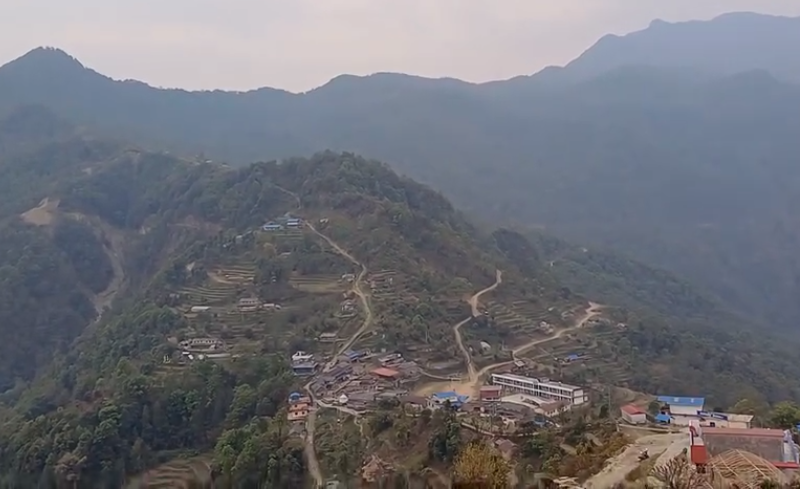Panchase : A new destination

- Bheshjung Badal
Panchase, about 233 km via Prithvi Highway from Kathmandu and situated at the meeting-point of Kaski, Parbat and Syangja districts of Gandaki Pradesh in the western region on Nepal, lies about 2500 meters above sea level and is the place of the meditation of Srabankumar of Aandhikhola. It is the point of of the great Harpan of Lake Phewa and the origin of Andherikhola. It is also the origin of Ratikhola and Jerekhola in the Parbat Region.
Panchase, the 5 peaks which literally also means 5 sacred seats, is an ancient pilgrimage climb. The climb itself holds a great significance in Yoga. The temple of Shidda Baba (Lord shive), Homekunda (place for ritual of offerings to fire), Panchase Lake, Balaji Phachyan Temple, Bouddha Stupas (about 200 years old) and caves are main attractions of the area , according to Machhapucchare Development Organization.
“Shrawan Kumar’s Samadhi, another religious spot is about 25 hours south downward from Panchase peak near a pond. According to legend in Ramayana, Shrawan Kumar, who was loyal, loved and served his parents, was carrying his blind parent to Muktinath pilgrimage, while at the same time king Dasarath was hunting in the same place. When Shrawan Kumar was filling the water bucket to quench the thirst of his beloved parents, it sounded like an animal roar, and the king shot his arrow towards the roaring sound unfortunately killing Shrawan Kumar. Realizing this, the king asked forgiveness with the blinds, but they never forgave the kind and cursed him that he would suffer the same fate and cried till death. That is why the river sprouting from there is called Aandhi Khola, river from the tears of the blinds,” according to MDO information on Panchase.
The Lake Phewa, the city of Pokhara, various rural municipalities of Kaski District and headquarters of Syangja and Parbat is seen from Panchase.The longest chain of mountain range visible from Panchasse include Mt. Dhawalagiri (8,172m), Mt.Annapurna I (8,091m) Mt Annapurna South (7,219m), Mt Hiuchuli(6,441m) Mt.Machapuchhare (6993m), Mt. Annapurna II(7,934m), Mt Annapurna III (7575m), Mt Annapurna IV(7525m), Mt Lamjung (6,998m), Mt. Manaslu and more.
The view of sunset and sunrise is another attraction of Panchase . Panchase is a region full of natural beauty and bio-diversity. Any part of the region of Panchase is accessible from Kaski, Parbat and Syangja districts by walk of about 3 hours.
Panchase is famous as a place of Siddhas and Meditation from the ancient time. According to the mythical accounts of the Puranik Age, Srabankumar had taken his parents to visit Muktinath and Gosaikunda in course of the tour of visiting all holy sites. People living within the area regard it as the place for performing ceremony in memory of the ancestors . It is also said that there was a big temple of Balaji in Panchase.
Besides its religious importance, Panchase is a place full of forest resources. About 1500 hectares of wild region is around it. Machhapuchhre Development Association is active in this area since the last 15 years for protection of natural resources. The Government of Nepal and various other non-governmental organizations have been working hand in hand to increase environmental consciousness about the area.
The Panchase touristic area is composed of the combination of 5 peaks. All these peaks have their own religious importance and is also called Panchadham. Efforts are being made to develop it as popular destinations . It is considered as the form of Jyotirlinga of Shiva and there are several mythical accounts of Shiva doing the meditation in this area.
The Siddhababa and Baraha Temple, Pancha Sarober and Buddhist Prayer Temple of Arthar Dandakharka, the Ghayansidanda of Wangsing and the monastery of Pumdibhumdi, among others and the temples of Gods and Goddesses in other areas of Panchase are considered as important for religious pilgrimage. Several courtyards and ancient remnants of Aarukharka Durbar have tremendous historical importance and all these have brought the prospect of tourism into the public eyes.
Another important aspect for the development of tourism is the combined habitations of Brahmins, Kshetris, Guungs, Magars,Damais, Kamis etc. The people of Panchase are known as Gorkhalis in different parts of the world. The local social and cultural resources are considered to be highly important for the development of tourism in the area.
Both dense and sparse habitations are found in Panchase area. The houses and dwellings made with local resources can be a source of attraction to the tourists visiting area. Many unoccupied houses can be used for the development of community home-stay for the tourists.
The life of the people of Panchase region is based on mixed types of occupation. They are engaged in agricultural production, animal husbandry and the cultivation of medication herbs. Such local products from the area can generate income to the local people from the tourists. It can help the alleviation of poverty in the area.
There are areas of snowfall and heavy rain in Panchase. The snowfall can attract the tourist and rainfall is useful for agriculture. The agricultural products can be used for domestic consumption and tourists.
The upper part of Panchase is covered with trees and forest. This area is rich for flowers orchids and medicinal herbs. There are more than 300 varieties of plants and trees and wild animals like bears, leopards, deer, jackals, porcupines, monkeys squirrels and different varieties of birds in the area.
( The writer is a Freelance Journalist .)
17 April 2024














